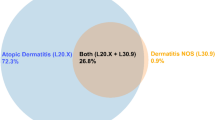Abstract
Background: The use of expert opinion is widespread in economic studies of healthcare utilisation; however, few studies have attempted to assess the validity of assumptions derived from such sources.
Objective: To examine the use of such expert opinion in determining comorbidities associated with atopic dermatitis/eczema (AD/E), which were assessed as part of a recent third-party payer cost-of-illness study.
Design: To identify the disease-related comorbidities that would represent costs associated with AD/E, physicians on an expert panel were asked individually and then collectively to group all International Classification of Diseases, 9th Edition—Clinical Modification (ICD-9-CM) diagnosis codes as ‘most likely’, ‘possibly’ or ‘definitely not’ related to the costs of identifying and treating patients with AD/E. Claims representing $US464 million in payer reimbursements from nearly 125 000 patients with AD/E were identified within two separate claims databases (1997 values). Over 850 ICD-9-CM diagnosis codes were identified in the first-listed position from these claims. For each group of ‘most likely’, ‘possibly’ and ‘definitely not’ related diagnosis codes, prevalence rates were compared within AD/E and non-AD/E populations from the two historical payer claims databases. Adjusted and non-adjusted odds ratios were calculated by comparing prevalence rates between AD/E and non-AD/E patients in the same payer population.
Results: The mean prevalence rate of any diagnosis code in the AD/E population was 0.65 ± 1.82% (SD) with a mean odds ratio of 1.81 ± 0.96. Comorbidities considered by the expert panel ‘most likely’ to be associated with AD/E had higher prevalence rates (3.28 ± 3.63%) and odds ratios (2.14 ± 1.14). Comorbidities considered to be ‘possibly’ related to AD/E had prevalence rates and odds ratios of 3.01 ± 5.06% and 1.84 ± 0.82, respectively. Comorbidities considered to be ‘definitely not’ related to AD/E had the lowest prevalence rates (0.45 ± 1.09%) and odds ratios (1.80 ± 0.97).
Conclusions: Comparing the result of consensus panels with actual claims histories validated the use of expert opinion in determining comorbidities associated with AD/E. Expert opinion yielded valid results in terms of identifying comorbidities that manifested frequently and disproportionately in the AD/E population. Limited statistical measurements of comorbidities would have been less specific than expert opinion. Future cost-of-illness studies should consider alternative data sources and methodologies to enhance the validity and importance of expert opinion and to corroborate their findings.





Similar content being viewed by others
References
Tonelli MR. In defense of expert opinion. Acad Med 1999; (74) 11:1187–92
Jones J, Hunter D. Qualitative research: consensus methods for medical and health services research. BMJ 1995; 311: 376–80
Kitzinger J. Qualitative research: introducing focus groups. BMJ 1995 Jul 29; 311 (7000): 299–302
Griffiths RI, Schrammel PN, Morris GL, et al. Payer costs of patients diagnosed with epilepsy. Epilepsia 1999 Mar; 40 (3): 351–8
Heaney DC, Shorvon SD, Sander JW, et al. Cost minimization analysis of antiepileptic drugs in newly diagnosed epilepsy in 12 European countries. Epilepsia 2000; 41 Suppl. 5: S37–44
Sackman H. Delphi critique. Lexington (MA): Lexington Books, 1975
Evans C. The use of consensus methods and expert panels in pharmacoeconomic studies: practical applications and methodological shortcomings. Pharmacoeconomics 1997 Aug; 12 (2 Pt 1): 121–9
Pill J. The Delphi method: substance, context, a critique and an annotated bibliography. Socioecon Plann Sci 1970 Jun; 5: 57–71
Evans C, Crawford B. Expert judgement in pharmacoeconomic studies: guidance and future use. Pharmacoeconomics 2000 Jun; 17 (6): 545–53
Longo CJ. Choices of methodology in pharmacoeconomic studies. Med Care 1999; 37: AS32–5
Minshall ME, Kody MC, Mosbacher F. Pharmacoeconomics research credibility: a controversial and recurring theme in health outcomes research. Med Care 1999; 37: AS12–9
Ellis CN, Drake LA, Prendergast MM, et al. Cost of atopic dermatitis and eczema in the United States. J Am Acad Dermatol 2002 Mar; 46 (3): 361–70
Begley CE, Famulari M, Annegers IF, et al. The cost of epilepsy in the United States: an estimate from populationbased clinical and survey data. Epilepsia 2000; 41 (3): 342–51
Ray NF, Baraniuk IN, Thamer M, et al. Direct expenditures for the treatment of allergic rhinoconjunctivitis in 1996, including the contributions of related airway illnesses. J Allergy Clin Immunol 1999 Mar; 103 (3 Pt 1): 401–7
Ray NF, Baraniuk IN, Thamer M, et al. Healthcare expenditures for sinusitis in 1996: contributions of asthma, rhinitis, and other airway disorders. J Allergy Clin Immunol 1999 Mar; 103 (3 Pt 1): 408–14
Smith DH, Malone DC, Lawson KA, et al. A national estimate of the economic costs of asthma. Am J Respir Crit Care Med 1997; 156: 787–93
Wilson L, Devine EB, So K. Direct medical costs of chronic obstructive pulmonary disease: chronic bronchitis and emphysema. Respir Med 2000; 94: 204–13
Tofte SJ, Hanifin JM. Current management and therapy of atopic dermatitis. J Am Acad Dermatol 2001; 44 (1 Suppl.): S13–6
Drake L, Prendergast MM, Maher R, et al. The impact of tacrolimus ointment on health-related quality of life of adult and pediatric patients with atopic dermatitis. J Am Acad Dermatol 2001; 44 (1 Suppl.): S65–72
Hadorn DC, Baker D, Hodges IS, et al. Rating the quality of evidence for clinical practice guidelines. J Clin Epidemiol 1996; 49: 749–54
SPSS 10.0 statistical software. Chicago (IL): SPSS, Inc., 1999
Bloom B, Bruno DJ, Maman DY, et al. Usefulness of US costof-illness studies in healthcare decision making. Pharmacoeconomics 2001; 19 (2): 207–13
Acknowledgements
Supported by Fujisawa Healthcare, Inc. All physician authors were compensated for their time serving on the advisory board for this work. Ms Prendergast is an employee of Fujisawa. Dr Ellis and Mr Tong are consultants to Fujisawa. Drs Ellis, Drake, Abramovits, Boguniewicz, Daniel, Lebwohl, and Whitaker-Worth have been investigators for clinical trials sponsored by Fujisawa. Drs Drake, Abramovits, Boguniewicz, Stevens, and Whitaker-Worth have been compensated by Fujisawa for speaking engagements. Dr Stevens has received a research grant from Fujisawa.
Author information
Authors and Affiliations
Corresponding author
Rights and permissions
About this article
Cite this article
Ellis, C.N., Drake, L.A., Prendergast, M.M. et al. Validation of expert opinion in identifying comorbidities associated with atopic dermatitis/eczema. Pharmacoeconomic 21, 875–883 (2003). https://doi.org/10.2165/00019053-200321120-00004
Published:
Issue Date:
DOI: https://doi.org/10.2165/00019053-200321120-00004




